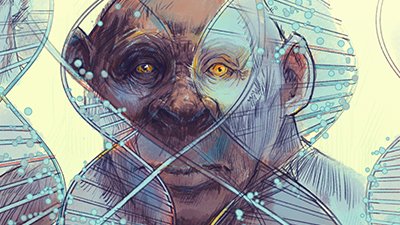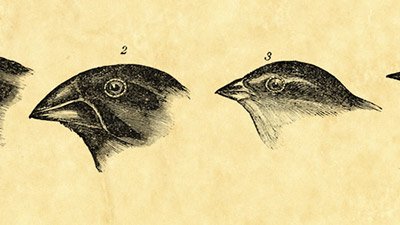
Has Evolution Really Been Observed?
What about wingless beetles, antibiotic resistance, peppered moths and beneficial mutations?
Molecules-to-man evolution requires that non-intelligent processes could produce vast quantities of functional complex information.
Molecules-to-man evolution is the theory that everything made itself, and that no creator was necessary. But this requires that non-intelligent processes could produce vast quantities of functional complex information. Even the simplest free-living organism carries the equivalent information of a 500-page book; humans have as much information as a thousand 500-page volumes.
A big obstacle for evolutionary belief is this: What mechanism could possibly have added all the extra information required to transform a one-celled creature progressively into pelicans, palm trees, and people? Natural selection alone can’t do it—selection involves getting rid of information. A group of creatures might become more adapted to the cold, for example, by the elimination of those which don’t carry the genetic information to make thick fur. But that doesn’t explain the origin of the information to make thick fur.
Also, natural selection by definition is the survival of the fittest, meaning those who leave the most surviving offspring. Therefore it requires self-reproducing entities to start with. So it is powerless to explain the origin of the vast quantities of information of the first self-reproducing cell.
For evolutionists there is only “one game in town” to explain the new information which their theory requires—mutations. These are accidental mistakes as the genetic (DNA) information (the coded set of instructions which is the “recipe” or “blueprint” specifying the construction and operation of any creature) is copied from one generation to the next.
Naturally, such scrambling of information will often be harmful—thousands of hereditary diseases in people, for instance, are caused by just such inherited mutational defects. At best they may be neutral—having no effect on the outcome, or the expressed meaning of the code. Using English as an (admittedly limited) analogy, assume a message were transmitted saying “the enemy is now attacking”, which accidentally suffers a one-letter substitution changing it to “the enemy is not attacking”. The result is potentially disastrous, like a harmful mutation. Whereas a change to “tha enemy is now attacking” would be neutral; a change, but not affecting the end result.
This is not surprising—an analogy: new computer programs do not arise from old computer programs by copying errors. Instead, the resulting program usually jams.
However, evolutionists believe that occasionally, a “good” mutation will occur which will be favoured by selection and will allow that creature to progress along its evolutionary pathway to something completely different.
The Wrong Type of Change
Are there “good” mutations? Evolutionists can point to a small handful of cases in which a mutation has helped a creature to survive better than those without it. Actually, they need to take a closer look. Such “good” mistakes are still the wrong types of changes to turn a fish into a philosopher—they are headed in precisely the wrong direction. Rather than adding information, they destroy information, or corrupt the way it can be expressed (not surprising, since they are random mistakes).
Wingless Beetles
For example, beetles losing their wings. A particular winged beetle type lives on large continental areas; the same beetle type on a small windy island has no wings.
What happened is easy to imagine. Every now and then in beetle populations, there might be a mutational defect which prevents wings from forming. That is, the “wing-making” information is lost or scrambled in some way.
The damaged gene (a gene is like a long “sentence” carrying one part of the total instructions recorded on the DNA) is then going to be passed to all that beetle’s offspring, and to their offspring, as it is copied over and over. All these descendant beetles will be wingless.
If a beetle with such a wingless defect is living on the Australian mainland, for example, it will have less chance to fly away from beetle-eaters, so it will be more likely to be eliminated by “survival of the fittest” before it can leave offspring. Such so-called “natural selection” can help to eliminate (or at least reduce the buildup of) such genetic mistakes.
However, on the windy island, the beetles which can fly tend to get blown into the sea, so not having wings is an advantage. In time, the elimination of all the winged ones will ensure that only those of this new “wingless” variety survive, which have therefore been “naturally selected”.
“There!” says the evolutionist. “A favourable mutation—evolution in action!” However, it fails to make his case, because though beneficial to survival, it is still a defect—a loss or corruption of information. This is the very opposite of what evolutionists need to demonstrate real evolution.
To support belief in a process which has allegedly turned molecules into man would require mutations to add information. Showing that information-losing defects can give a survival advantage is irrelevant, as far as evidence for real evolution is concerned.
Similarly, many animals in caves are blind, with shrivelled eyes. A mutation causing shrivelling of the eye and loss of sight would not harm the individual in a cave with no light to see by anyway. And it would even be beneficial, since there is less chance of injuring a delicate eyeball. But in the light, such blind mutants would be eliminated by natural selection.
Antibiotic Resistance
Some antibiotic resistance was already present in the bacterial population, as shown by specimens frozen before the development of antibiotics. So natural selection only selected from pre-existing variation. But nothing new was produced. Similarly, myxomatosis-resistant rabbits were already present in the population. When myxomatosis was introduced to Australia, non-resistant rabbits were selected against. But this processes caused the loss of information from the bacteria and rabbit population due to the loss of genetic diversity.
Also, a loss of information can cause bacterial antibiotic resistance, e.g. penicillin resistance in Staphylococcus can be due to a mutation causing a regulatory gene’s loss of control of production of penicillinase (an enzyme which destroys penicillin). The resulting overproduction of penicillinase increases resistance to penicillin. But in the wild (away from artificial environments swamped with penicillin), the Staphylococcus would be less “fit” because it wastes resources producing heaps of unnecessary protein.
Another common cause of antibiotic resistance is mutational defects which hinder the bacterium’s ability to transport substances through its cell membrane. Such a defect means that the antibiotic is less readily absorbed, so it is less likely to kill the bacterium. But in the wild, it would be unable to compete with bacteria with properly working cell membrane pumps which take up nutrients into the cell.
Of the many cases of antibiotic resistance studied, none have involved the production of new functionally complex information, such as a new enzyme. This would be real evolution, but such has not been found. Sometimes bacteria have acquired resistance genes from other species via viruses or by direct transfer through tiny tubes, but this is not the addition of new information to the biosphere as a whole. Bacteria only produce bacteria “after their kind”, not a different type of creature.
Viruses are sometimes said to “evolve”, but what really happens is that mutations cause the changes to their protein coats. There is no increase in complexity, but sometimes the changes mean that antibodies do not recognise them. So the viruses are “fitter”, but there is still no increase in information.
A similar case is a recent discovery that some antibiotic-resistant bacteria have abnormally high mutation rates. This is caused by a mutation in the genes for the sophisticated genetic proof-reading mechanisms present in all life. This means there is more chance of errors not being corrected. Sometimes one of these defects happens to result in antibiotic resistance, as explained above.
Peppered Moths and Breeding
One common fallacy promoted by evolutionists is that variation within a kind somehow proves particles-to-people evolution. The examples commonly cited, e.g. peppered moths and the Gal‡pagos finches, are indeed examples of natural selection. But this is not evolution, since not new information has arisen. Given a pre-existing gene pool, different combinations of the genes arise through sexual reproduction and some of those may be better able to survive. So natural selection can account for the formation of different varieties, but cannot account for the origin of moths or finches. With the peppered moths, even were we to grant the truth of the story, all it would show is that natural selection changed the ratios of black and peppered forms. They were already present in the population, so nothing new was produced. And more recently, the whole story has been shown to be based on faked photos of moths glued on to tree trunks—the moths almost never rest there in real life.
It’s also important to note that rapid speciation, involving no gain of genetic information, is in fact a prediction of the creation model. It explains how many varieties could arise from comparatively few “kinds” on board the Ark.
The different breeds of cattle and dogs are quite consistent with creation of separate types—e.g. a canine kind and a bovine kind, with large amounts of information. Man chose the animals with the characteristics he wanted, and bred from them. Thus the information for certain desired characteristics was concentrated in smaller selected populations. But the resulting breeds have all lost the information for the characteristics not wanted by man. Therefore, these breeds have less information than the wild type, so again the change is not of the right sort for molecules-to-man evolution. And they are still cattle and dogs, not different types of creature.
Summary
- Evolutionary theory requires some mutations to go “uphill’—to add new information.
- The mutations which we observe are generally neutral (they don’t effectively change the information, or the “meaning” in the code) or else they are informationally downhill—defects which lose/corrupt information.
- The rare “beneficial” mutations to which evolutionists cling all appear to be like wingless animals, blind cave animals, and many examples of antibiotic resistance. They are downhill changes, losses of information which, though they may give a survival advantage, are headed in precisely the wrong direction for evolution.
- The examples commonly cited as “evolution happening today” usually involving adaptation by natural selection, are without exception instances in which the net result is a loss of information in the population—either by mutation or by way of reduced genetic variety.
All of our real-world experience, especially in the “information age”, would indicate that to rely on accidental copying mistakes to generate real information is the stuff of wishful thinking by “true believers”, not science.
Recommended Resources

Answers in Genesis is an apologetics ministry, dedicated to helping Christians defend their faith and proclaim the good news of Jesus Christ.
- Customer Service 800.778.3390
- Available Monday–Friday | 9 AM–5 PM ET
- © 2025 Answers in Genesis





